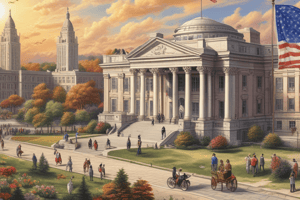Podcast
Questions and Answers
What was the primary goal of Henry Clay's American System?
What was the primary goal of Henry Clay's American System?
- To discourage internal improvements and infrastructure development.
- To decrease tariffs on imported goods to foster free trade.
- To increase America's reliance on European manufactured goods.
- To promote American industry and reduce dependence on foreign nations. (correct)
Which of the following was a key component of the American System designed to protect nascent industries?
Which of the following was a key component of the American System designed to protect nascent industries?
- Imposing protective tariffs on imported goods. (correct)
- Encouraging free trade agreements with European nations.
- Eliminating all taxes on domestic goods.
- Reducing government spending on infrastructure.
What role did infrastructure play in Henry Clay's vision for the American System?
What role did infrastructure play in Henry Clay's vision for the American System?
- Infrastructure projects were solely the responsibility of private investors and not the government.
- Infrastructure improvements were intended to facilitate the movement of goods and promote national unity. (correct)
- Infrastructure development was deemed unnecessary and was not a part of the plan.
- Infrastructure was only to be developed in the northern states and not the southern states.
Why did Henry Clay and other proponents believe that a national bank was essential to the American System?
Why did Henry Clay and other proponents believe that a national bank was essential to the American System?
How did the War of 1812 influence the creation of the American System?
How did the War of 1812 influence the creation of the American System?
Which political party adopted many of the ideas of the American System in the mid-1850s?
Which political party adopted many of the ideas of the American System in the mid-1850s?
What was the main reason why Southerners opposed tariffs, a key component of the American System?
What was the main reason why Southerners opposed tariffs, a key component of the American System?
Which of the following infrastructure projects received federal funding under the American System?
Which of the following infrastructure projects received federal funding under the American System?
Who initially promoted the ideas that would later form the basis of the American System?
Who initially promoted the ideas that would later form the basis of the American System?
What event led to a drastic reduction in federal government spending on infrastructure and challenged the renewal of the National Bank's charter?
What event led to a drastic reduction in federal government spending on infrastructure and challenged the renewal of the National Bank's charter?
Flashcards
American System
American System
An economic plan to make the U.S. more self-reliant and less dependent on Europe.
Henry Clay
Henry Clay
Kentucky Congressman, Speaker of the House and Senator who promoted the American System.
Infrastructure (American System)
Infrastructure (American System)
Building roads, canals to improve transport of goods throughout the U.S.
Protective Tariffs
Protective Tariffs
Signup and view all the flashcards
National Bank (American System)
National Bank (American System)
Signup and view all the flashcards
Erie Canal
Erie Canal
Signup and view all the flashcards
Southern Opposition to Tariffs
Southern Opposition to Tariffs
Signup and view all the flashcards
Republican Party's Economic Role
Republican Party's Economic Role
Signup and view all the flashcards
Study Notes
- The American System was an economic plan intended to make the U.S. more self-reliant economically and less dependent on Europe, especially Great Britain.
- Henry Clay created and promoted the American System.
- It was created in 1815 in a speech by Henry Clay.
- Clay was a Congressman, Speaker of the House, and Senator from Kentucky.
- The American System included tariffs, infrastructure development, and a national bank to promote the American economy.
- It was based on Alexander Hamilton's "American School" approach.
Background
- The American System was an extension of the American School, promoted in the 1790s by Alexander Hamilton.
- This economic policy existed in various forms from the 1790s into the 20th century.
- After the War of 1812, many Americans believed that America should become self-sufficient.
- Generating industry and creating markets for its agricultural products was believed by Americans to be the way to make America economically viable regardless of what other nations might do.
The American Economy During the Early 19th Century
- In the early 19th century, America was primarily a rural country.
- Most manufactured goods were purchased abroad, mainly from Great Britain.
- Events in Europe heavily influenced America's economy.
- Consumers in America had to pay the prices demanded by foreign governments.
Henry Clay
- Henry Clay was born in Virginia in 1777.
- In 1818, as Speaker of the House, Clay proposed what became known as the American System.
- Clay realized the difficulty of moving goods from Kentucky and that most manufactured goods were imported from Europe.
- The American System would allow America to develop American industry and become less dependent on foreign trade.
- Clay saw that infrastructure needed to be built and tariffs enacted to protect industries from foreign competition.
Goal of the American System
- The goal was to promote American industry and make the U.S. less reliant on foreign nations.
- Three main ideas were proposed: infrastructure, protective tariffs, and a national bank.
Infrastructure
- Building canals and roads would allow American goods to be transported throughout the country easier, faster, and cheaper.
Protective Tariffs
- Tariffs are taxes on imported goods.
- Imposing tariffs on manufactured goods from foreign nations would increase their cost, allowing for cheaper American-made goods.
- Americans would purchase the less expensive American-made products instead of the foreign ones.
- American industry would grow because they were competing with costlier foreign goods.
- The tariffs collected would be used to build the nation's infrastructure.
National Bank
- Creating a National Bank would provide the country with one currency.
- This bank would allow trade and commerce to be transacted much easier.
Internal Improvements and Infrastructure
- Clay wanted the federal government to assist the states in funding roadways and canals.
- This would unite the nation and allow goods to be traded more efficiently and cheaper.
- Clay believed federal help would interconnect these projects, benefiting the entire country.
- The infrastructure would be paid for using money collected from tariffs.
- Projects aided by federal funding were the Erie Canal, Cumberland Road, and Lancaster Turnpike.
- These roads and canals would unite the various regions in America.
Tariffs and Trade Protectionism
- Tariffs increase the prices of foreign goods, allowing American manufacturers to sell lower-cost goods internally.
- American-produced goods should be cheaper because they don't have tariffs.
- The money collected from tariffs would be used to pay for infrastructure.
- Southerners opposed the tariffs because they exported raw materials and agricultural products.
- They believed foreign nations would place tariffs on their exports.
- Many southerners did not see the benefits of becoming an industrialized nation.
Establishment of a National Bank
- The first National Bank, established by Alexander Hamilton, closed in 1811 after 20 years.
- After the War of 1812, a new National Bank was established in February 1816 and was to run through 1836.
- The primary role was to control the credit market and guide the U.S. to less speculative currencies.
- Clay believed that by being part owners of the National Bank, they would receive annual dividends.
- The National Bank could guide the American economy through systemic growth and make paper money the standard currency.
Creation of the American System
- The American System was created after the War of 1812.
- The ideas were first laid out in 1815 but not named until 1824.
- Congress approved aspects of the plan at various times, starting with tariffs and the National Bank in 1816.
American System and Related Legislation
- The Tariff of 1816 and the 1816 charter of the National Bank were significant aspects.
- Over the next twelve years, additional laws were enacted that helped the American System, specifically in infrastructure.
- Andrew Jackson vetoed Clay's proposal to build the National Road to Maysville, Kentucky.
- Jackson did not believe in federal spending on infrastructure and did not want to help Clay.
Speeches on the American System
- Clay gave numerous speeches advocating for the American System.
- A major speech was given in March 1824, when Clay was Speaker of the House, that referred to the program as the American System.
- Another speech was in 1832, defending the American System from Andrew Jackson's attempts to limit infrastructure spending and destroy the Bank of the United States.
- Federal spending on infrastructure was drastically reduced, and the bank's charter was not renewed in 1836.
Significance of Henry Clay's American System
- The federal government aided in building infrastructure in the United States.
- State and local governments contributed to the cost of infrastructure projects.
- The New York State Erie Canal system was paid for by the New York state government and private investors.
- The canals and roads built allowed goods to be transported more efficiently.
- In the 1860s, the Transcontinental Railroad was sponsored by the federal government.
The Republican Party and Economic Development
- The Whig party died out, and the Republicans, supporting the American System, emerged in the mid-1850s.
- Under Abraham Lincoln, the U.S. created a unified currency called greenbacks.
- The Pacific Railways Act of 1862 spurred the building of a rail system connecting California with the rest of the country.
Studying That Suits You
Use AI to generate personalized quizzes and flashcards to suit your learning preferences.




